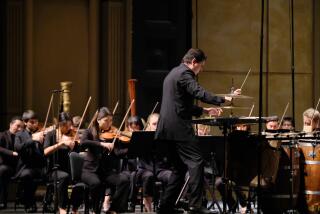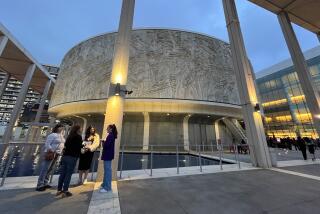Long Wait for Arts Recovery? : Funding: Two studies suggest that symphony orchestras and art museums, already damaged by the recession, may not bounce back for four or five years.
The nation’s symphony orchestras and art museums have been badly damaged by the recession, and a changing government and corporate financial landscape for the arts may mean recovery could take four or five years, according to a pair of studies by a New York consulting firm.
The squeeze may have inflicted permanent damage on the mixed public-private system of support for cultural institutions nationwide, concludes research consultant James Abruzzo of the firm of A. T. Kearney Inc..
The situation has been aggravated by the combination of deficit financing at the local, state and federal government levels and the recession-driven decline of corporate profits.
At the same time, says the consulting firm, corporations have begun reassessing their philosophies for supporting cultural activities. More and more, companies expect merchandising results from arts activities and want to support blockbuster shows and concert extravaganzas intended to reach large, upscale audiences.
Corporations “want things that are hot and popular--big draws,” said Abruzzo of the emerging new corporate arts philosophy. “They are more and more interested in the demographics of who comes to a particular exhibition.”
The new studies--based on separate surveys of 51 symphonies and 110 art museums--were supervised by Abruzzo, managing director of Kearney’s nationwide consulting and executive search division devoted to nonprofit corporations.
The firm surveyed symphony orchestras independently in late February and conducted its art museum research in March in cooperation with the Assn. of Art Museum Directors, whose members include the heads of the 150 largest institutions in the country. Results of the two studies have been distributed among major arts organizations over the last few weeks.
“This confirms what we suspected: That museums have taken a hit,” said John Walsh, director of the J. Paul Getty Museum in Malibu and former president of the Assn. of Art Museum Directors of the Kearney museum study. “I think that (even) if the economy turned around in the next six months, it would take two more years for people to get their nerves back and (start to) increase cultural institutions’ allocations.
“The general picture is of a huge loss of operating income from (sources) museums had come to depend on, which is primarily corporate support, and, secondarily, state governments.”
Some cultural organizations said their situations have further deteriorated in the weeks since they filled out Kearney questionnaires. Deborah Rutter, executive director of the Los Angeles Chamber Orchestra, for instance, said that in the six weeks after her organization responded, a deficit that amounted to $50,000 in late March grew to between $150,000 and $200,000. The orchestra has a budget this year of $3.4 million. Rutter said the overall economic situation has convinced her the public may have to experience a revolution of reduced expectations for its cultural enterprises.
“I think we are going to have to stop looking at arts organizations and expecting them to constantly be bigger and growing,” she said. “We’ve been looking at our arts organizations as if they were tennis-shoe manufacturing companies. If you didn’t come out with a new brand, you weren’t a successful organization.”
Catherine French, executive director of the American Symphony Orchestra League, acknowledged that the combination of economic deterioration at all levels of government and the financial shots taken by the business economy may signal that this particular economic downturn will have more lasting--even permanent--effects on the arts than previous recessions.
“I think what’s happening right now is that so many state governments are in trouble and that there are changing corporate priorities and there are so many issues that corporations are being asked to address that (this cyclic change in cultural economics) may, indeed, be different,” French said.
Among their conclusions, the Kearney studies found that:
* Corporate contributions to 82% of the museums and 79% of the symphonies have undergone serious reduction as the economic downturn has continued. State government grants have been “very negatively” affected for 45% of museums and 40% of orchestras. Government support was off across the board--according to 82% of orchestras and 74% of museums.
* Some of the decline in funding from traditional major government and private sources has been offset by improved performance in donations by board members, individual contributions and ticket and subscription sales for orchestras and membership sales and admissions for museums. But the improvements have paled in comparison to the exodus of other funds.
* A temporary change in tax laws that restored deductions for the full value of artworks donated to museums in 1991 prompted 9% of museum directors to say the tax situation helped them. But that was more than offset by the 17% of museums that reported “very negative” effects on donations of artworks precipitated by the deteriorating economy.
* The economic decline has forced givers to play nonprofit organizations off against one another for donations and museums and symphonies have found they are being accorded lower priorities compared to private social programs, environmental organizations and organizations specializing in international affairs. Nearly three-quarters of the museums and 37% of the orchestras reported they were being accorded lower priorities by private funder than before the economy began its slide.
“Corporations are reallocating their money to other philanthropic ventures,” Abruzzo said. “The arts are not as hot or as popular to give to.”
More to Read
The biggest entertainment stories
Get our big stories about Hollywood, film, television, music, arts, culture and more right in your inbox as soon as they publish.
You may occasionally receive promotional content from the Los Angeles Times.










